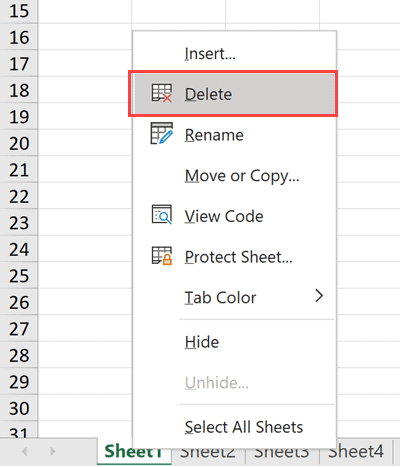Quick Guide: Excel Sheet Deletion Shortcut Explained

Managing Excel sheets efficiently can significantly streamline your workflow, especially when working with large and complex spreadsheets. One key action many users perform regularly is deleting unwanted sheets. Understanding Excel sheet deletion shortcuts can make this task quicker, easier, and less prone to errors. In this guide, we'll delve into the various methods to delete sheets in Excel using keyboard shortcuts, making your life as an Excel power user much simpler.
Using Keyboard Shortcuts for Sheet Deletion

Excel has a robust set of keyboard shortcuts that can help you manage your spreadsheets. Here’s how to delete a sheet using just your keyboard:
- Windows:
- Select the sheet you wish to delete by clicking its tab at the bottom of the Excel window.
- Press
ALT+E, then release both keys. - Promptly press
Lto open the Delete dialog. - Press
Dto confirm the deletion.
- Mac:
- Select the sheet you wish to delete by clicking its tab at the bottom of the Excel window.
- Press
CTRL+-to open the Delete dialog. - Press
EnterorReturnto confirm the deletion.
⚠️ Note: Always make sure you have no unsaved changes in the sheet you are about to delete. This action is irreversible unless you have an auto-backup or recovery system in place.
Alternative Methods to Delete Sheets

If keyboard shortcuts are not your preference, here are other ways to delete sheets in Excel:
- Using the Right-Click Context Menu:
- Right-click on the tab of the sheet you want to delete.
- Select Delete from the context menu.
- Confirm the deletion in the dialog box that appears.
- Via Excel's Ribbon:
- Select the sheet by clicking its tab.
- Go to the Home tab on the Ribbon.
- Click on Cells in the Editing group.
- Choose Delete and then Delete Sheet from the dropdown menu.
💡 Note: Deleting sheets via the Ribbon or context menu also prompts a confirmation dialog, allowing for double-checking before the deletion.
Best Practices for Sheet Management

Here are some tips to manage your sheets more effectively:
- Save copies of your workbook before large deletions to avoid data loss.
- Use color coding for tabs to quickly identify which sheets are ready for deletion.
- Consider using a naming convention that indicates the purpose or status of sheets, like "Sheet1_Completed" or "Sheet2_Archive".
- Enable Excel's Change Tracking feature to keep records of edits, including sheet deletions.
| Action | Windows Shortcut | Mac Shortcut |
|---|---|---|
| Open Delete Sheet Dialog | ALT + E, L |
CTRL + - |
| Delete Sheet | D after opening dialog |
Enter or Return |
| Undo Deletion | CTRL + Z |
CMD + Z |

Throughout this guide, we've covered various methods to delete sheets in Excel, from shortcuts to mouse navigation. These shortcuts and tips are designed to save you time and reduce errors when managing sheets. Remember that while Excel offers ways to undo deletions, it's always prudent to double-check before confirming deletions due to their potential for irreversibility. By understanding these techniques and incorporating best practices, you can enhance your productivity and accuracy when working with spreadsheets.
Can I recover a sheet after I’ve deleted it accidentally?

+
If you have not saved the workbook after deleting the sheet, you might use Excel’s Undo feature (CTRL + Z for Windows, CMD + Z for Mac) to recover it. However, if you’ve saved the workbook, recovery can be complex without an auto-backup system.
Are there any macros or VBA scripts for sheet deletion?

+
Yes, you can write VBA scripts in Excel to automate sheet deletion. Here’s a simple example:
Sub DeleteSheet()
Dim ws As Worksheet
For Each ws In ThisWorkbook.Worksheets
If ws.Name Like “Sheet_” Then
Application.DisplayAlerts = False
ws.Delete
Application.DisplayAlerts = True
End If
Next ws
End Sub
This script deletes any sheet named with “Sheet” followed by an underscore.
How do I delete multiple sheets at once?

+
Currently, Excel does not support selecting and deleting multiple sheets at once via the UI or keyboard shortcuts. You’ll need to delete sheets one by one or use VBA for batch deletion.
What are the risks associated with deleting a sheet?

+
Deleting a sheet can permanently remove data if not saved elsewhere, break cell references in other sheets, or disrupt formulas or macros that depend on the deleted sheet.
How can I prevent accidental sheet deletions?

+
To prevent accidental deletions, you can:
- Use Excel’s Protect Workbook feature to lock the structure of the workbook.
- Regularly save your work.
- Be cautious with shortcuts and always confirm deletions.



